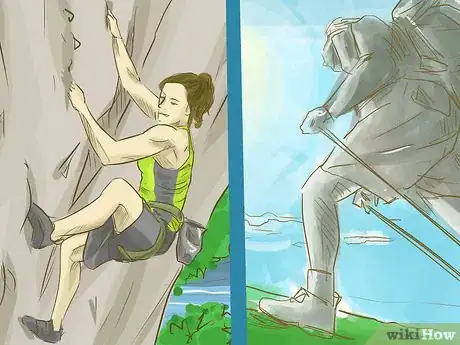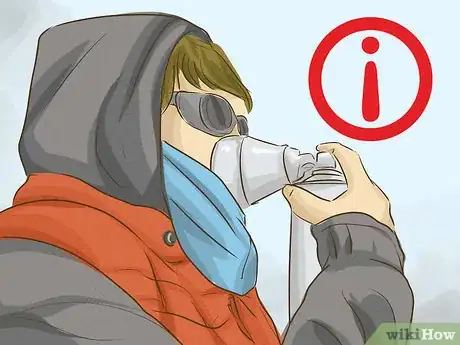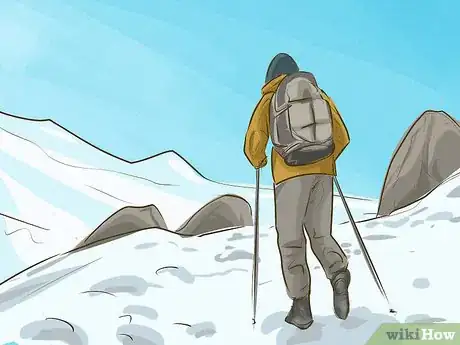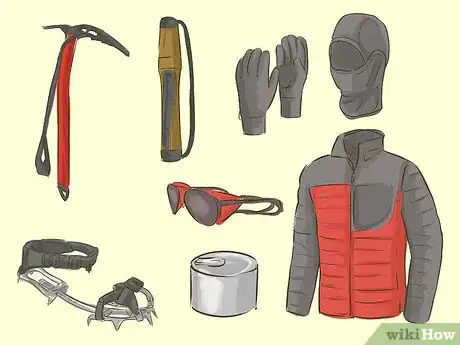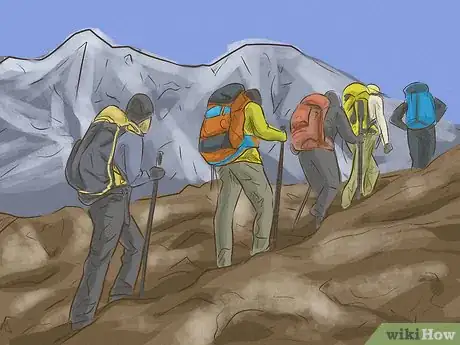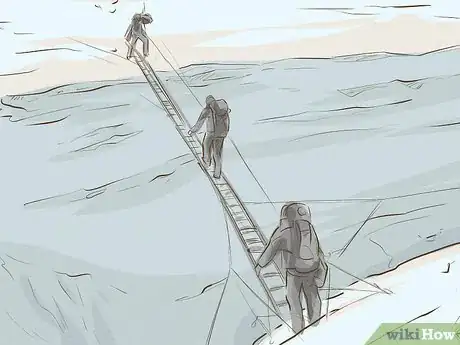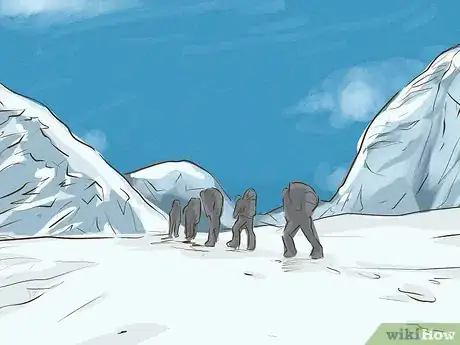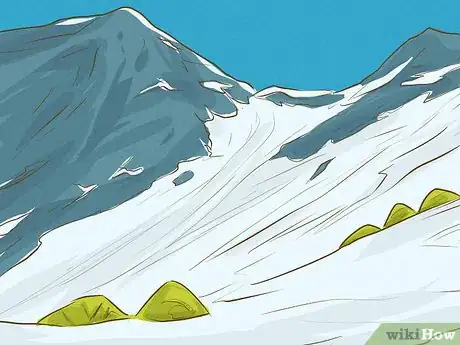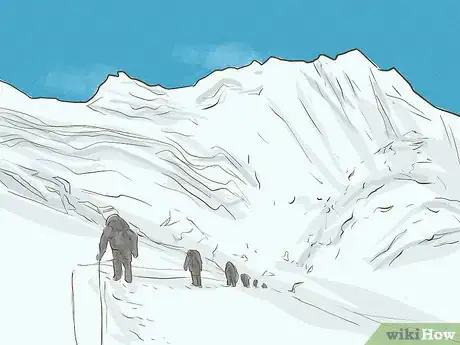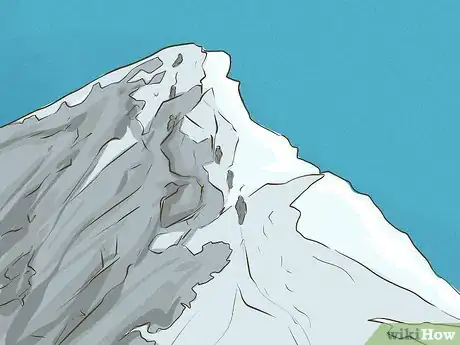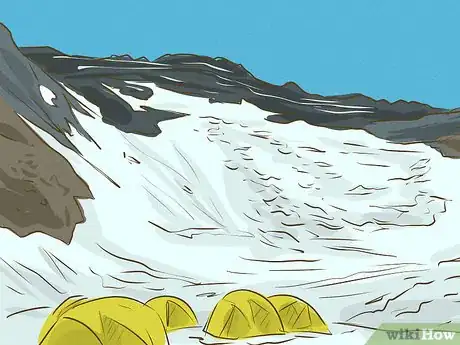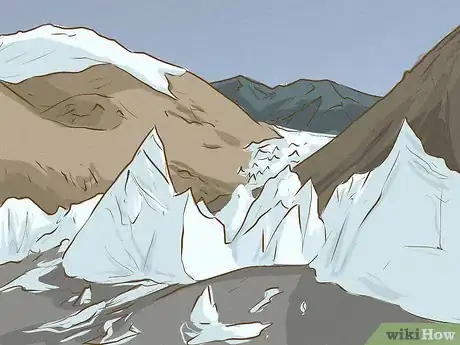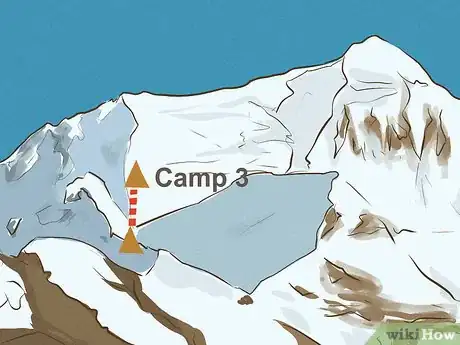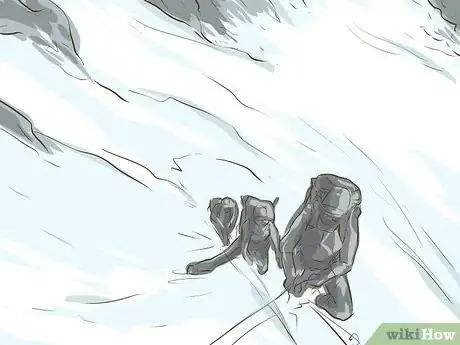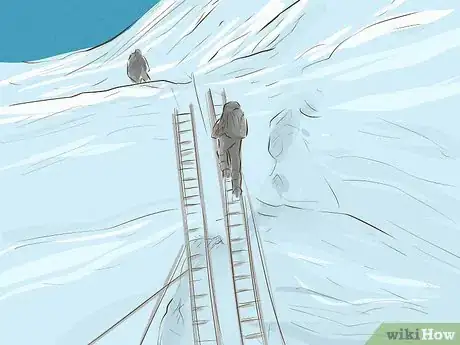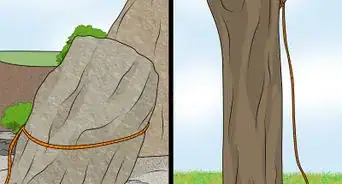This article was co-authored by Katie Prendergast. Katie Prendergast is a Certified Personal Trainer, Nutrition Coach, and the Owner of KPxFitness. With over seven years of coaching experience, she has expertise in helping skiers, snowboarders, and hikers build strength and endurance to enjoy more outdoor adventures. Katie earned her Personal Training Certification and Corrective Exercise Specialist Certification from The National Academy of Sports Medicine (NASM) and is a Pain-Free Performance Specialist (PPSC).
There are 7 references cited in this article, which can be found at the bottom of the page.
wikiHow marks an article as reader-approved once it receives enough positive feedback. In this case, several readers have written to tell us that this article was helpful to them, earning it our reader-approved status.
This article has been viewed 67,563 times.
Despite Mount Everest being the highest and most lofty mountain in the Himalayas, it is relatively easy to climb, if you take the right route. Even staying to the easier route up the southeast edge you will face dangers such as howling winds and extreme altitudes. Before climbing the mountain it is a good idea to improve your fitness and have a enthusiastic attitude towards the idea. The southeast route was first found and used by New Zealander Edmund Hillary and Sherpa Tenzing Norgay in 1953.
Steps
Preparation
-
1Get seriously fit. Everest challenges even the fittest people.[1] Not only is your physical strength challenged but so will your mental strength. Focus on exercises that will improve cardiovascular and strength. Practise walking up flights of stairs with weights. Try climbing other mountains first. As you improve your fitness, increase your workout length and intensity.
- Six months prior: Begin to get into a workout routine four times a week. Your workouts should be enjoyable such as jogging or cycling. Introduce yourself to medium intensity muscular exercises such as push-ups, chin-ups and sit-ups.
- Five months prior: Increase your workout length and intensity. You may want to increase your workouts to 6 days a week. Increase reps of muscular exercises. Introduce the climbing element to your workouts such as walking up steep hills while carrying a heavy backpack.
- Four months prior: Build up your aerobic endurance. You should now practise high intensity 45 minute aerobic workouts six days a week. Continue climbing exercises and only increase your backpack weight, if you are sure you are ready, otherwise you can damage your knees.
- Three months prior: At this point, you must be physically and mentally conditioned. Regularly take multivitamin tablets and small amounts of iron supplements. Iron helps your blood cells carry oxygen,[2] but too much is unhealthy. Maintain a healthy diet and increase your aerobic workouts to an hour. Continuing practising climbing, but make it harder such as sprinting up steep hills. Try to get an opportunity to go camping so you can improve your skills.
- Two months prior: Maintain your routines. Increase the length of aerobic workouts. Improve your endurance. Rather than focusing on how heavy you can lift, tone down the weight and see how many reps you can do in a minute. Get out in the wilderness and test out your gear. Remember to maintain a healthy diet and drink lots of water.
-
2Learn technical climbing skills. To climb Mount Everest you will need to understand mountaineering, climbing and navigational skills. Taking outdoor and navigational classes will help you. Your Everest expedition guide will also help you prepare for the mountain. Have a good understanding of bushwhacking, rope handling, river crossings, belaying and tying knots, rappelling, navigation, crevasse, and rock rescue skills. Merely taking care of urinating and bowel movements requires special techniques and extreme care in the low temperatures.Advertisement
-
3Prepare for the risks and dangers of climbing Everest. The most common ways of dying on the mountain are fatigue, ice falls, lack of oxygen, high altitudes, harsh weather conditions, and frostbite. Learn from the mistakes made by other climbers and understand the symptoms of altitude sickness, and its prevention techniques and emergency treatments.[3]
-
4Understand the death zone. Above 8,000 metres (26,000 ft) you will face significant challenges to survival. Any body part exposed will suffer frostbite. The temperature is so low that the ice is an extreme slipping hazard. The oxygen level is only 337 mbar, a third of the requirement normally needed to breathe.[4] The conditions are so harsh it takes most climbers up to 12 hours to walk the distance of 1.72 kilometres (1 mile) from South Col to the summit. To live in the death zone you will need about 50 days of altitude acclimatization for a typical expedition, otherwise you will lose consciousness in minutes.
- Since helicopters can't easily reach the summit, if you become unable to walk you will be left to die. It is not uncommon to come across dead bodies in the mountain.
-
5Build up experience. Even if you think you know everything, you probably don't. Have at least 3 years of mountaineering experience. Practise climbing other mountains that have high altitudes and extreme temperatures.
-
6Book an expedition company. Most expedition companies take groups of around 10 people with numerous Sherpas and several travel guides. The tour company will take care of your climbing permits and oxygen supplies. Sherpas are native to the Himalayan mountains of Nepal who will carry your food, load and equipment. They can also offer you support and help climbing the mountain. Expect to pay at least $60,000 for the expedition.
- Paying for a budget tour or not using a company at all puts your life more at risk. Generally the more you pay, the safer your climb will be. Hundreds of climbers who paid minimal prices have died.
-
7Organise your equipment. You will need to ask your expedition company for a list of equipment you will need bring. You will need mountaineering equipment such as ice axes and crampons, clothing such as gloves and headwear, and supplies such as food, a stove to thaw water and the food, and first aid materials.
Southeast Ridge Route
-
1Hike from Kathmandu base camp in Nepal to Base Camp on the Khumbu Glacier. Allow 6 to 8 days to complete the walk. The time consuming walk is beneficial as it will help you get used to the high altitudes. This camp is 5,380 m (17,700 ft). It is typical to spend a few days at the base camp to get used to the low oxygen levels so you will avoid altitude sickness. During your stay Sherpas will prepare ropes and ladders for the next part of your journey.
-
2Cross the Khumbu Icefall. The icefall is a moving glacier mass of tumbled ice with deep crevasses. It is best to start before dawn so that the freezing temperatures will weld the ice tightly together.[5] Proceed to Camp I which is at an altitude of 6,065 m (19,900 ft).
-
3Walk up the glacier of Western Cwm. The most direct route is gashed by deep ice and massive crevasses. The Western Cwm is a flat, gently rising glacial valley. You will arrive at the base of Lhotse face at Camp II or Advanced Base Camp (ABC) which is at an elevation of 6,500 m (21,000 ft).
-
4Ascend up Lhotse face to Camp III. This face is icy; so, you will need to use the fixed ropes which are permanently in place. They interlink so that you are constantly connected to a rope. The steep slopes of up to 50 degrees and hard ice make it easy for your crampons to slip. Camp III is at an altitude of 7,470 m (24,500 ft).
-
5Climb over Geneva Spur to Camp IV. The spur is a big, black rib or rock followed by hard yellow rock known as the Yellow Band. It was named by the 1952 Swiss expedition. There are fixed ropes to guide you in place. Camp IV (High Camp) is on the South Col which has an altitude of 7,920 m (26,000 ft).[6]
-
6Climb to the summit. You will need to wait for clear weather and low winds, otherwise you will have to descend, many meters back to Base Camp. The final section of climbing to the top includes walking up a series or steps made from rock and walking along a knife-edged ridge to a 12 m (40 ft) wall called Hillary Step. Climb up the snow slope and you will reach the top of the summit which is highest point on earth at 8,848 m (29,029 ft).
North Ridge Route
-
1Hike to the Advanced Base Camp from the north side of Mount Everest in Tibet. The route to the Advanced Base Camp (ABC) is 22 km (12 miles) is rugged and has lots of boulders, ice and snow. The path follows Rongbuk Glacier and then merges into Eastern Rongbuk Glacier. The ABC Camp is 6,400m (21,300 ft).
-
2Climb to the North Col via East Rongbuk Glacier. When you reach the East Rongbuk Glacier you will have to use crampons for the first time. After a short walk you can attach yourself to a fixed rope. This part gains significant altitude and some parts will feel vertical. It takes about 5 hours to reach the North Col (Camp I) which is at an elevation of 7,000 m (23,000 ft).
-
3Walk to Camp II. This section is known as the High Camps. The path is mostly snow with some rocks. This section is known for strong winds which prevail in the area. It takes about 4 hours to reach Camp II which is at an altitude of 7,500 m (24,750 ft). Many climbers use this camp for acclimatization purposes.
-
4Continue to Camp III along the windswept snow. Many climbers skip this camp and go directly to Camp IV. Camp III is at an altitude of 7,900 m (25,600 ft). Most climbers will need to sleep with supplemental oxygen. The route to the camp is extremely windy which means it can take you up to 6 hours to complete, however once you reach the camp you are protected by the North Face of the mountain. The camp is built on small rock ledges since there is not many open spaces on this part of the mountain.
-
5Proceed to Camp IV using the ropes. Follow the fixed rope through the snow filled gully. Then take the small ramp to the Northeast Ridge which is just under the camp. You do not want to spend a lot of time at the camp, it is basically just a rest stop. Camp IV is at an altitude of 8,300 m (27,390 ft).
-
6Get over the Three Steps. To get to the summit you will have to pass three rock features, called Three Steps. The first step requires hard pulling on fixed ropes to get over the Mushroom shaped rock. It is full of loose rock which is hard to walk over. The second step, the Chinese ladder is most intense. You will need to climb over a thick ice slab to climb on a vertical ladder with a 3,000 m (10,000 ft) drop. The third step is a straightforward rock climb, however under the extreme conditions it is very challenging.[7]
-
7Continue to the summit. Along the final stretch it is extremely cold, steep and windy. Towards the top of the pyramid there are more small rocks which are challenging to get over. The Summit Ridge is very exposed and has steep slope angles of up to 60 degrees. It has drop-offs on both sides of 3,000 m (10,000 ft). At the end of the ridge you will reach the highest point on earth at 8,848 m (29,029 ft).
Expert Q&A
-
QuestionWhat are some examples of cardio training I need to become an advanced hiker? I want to feel absolutely ready to walk Mount Everest.
 Katie PrendergastKatie Prendergast is a Certified Personal Trainer, Nutrition Coach, and the Owner of KPxFitness. With over seven years of coaching experience, she has expertise in helping skiers, snowboarders, and hikers build strength and endurance to enjoy more outdoor adventures. Katie earned her Personal Training Certification and Corrective Exercise Specialist Certification from The National Academy of Sports Medicine (NASM) and is a Pain-Free Performance Specialist (PPSC).
Katie PrendergastKatie Prendergast is a Certified Personal Trainer, Nutrition Coach, and the Owner of KPxFitness. With over seven years of coaching experience, she has expertise in helping skiers, snowboarders, and hikers build strength and endurance to enjoy more outdoor adventures. Katie earned her Personal Training Certification and Corrective Exercise Specialist Certification from The National Academy of Sports Medicine (NASM) and is a Pain-Free Performance Specialist (PPSC).
Certified Personal Trainer & Nutrition Coach For advanced hikes, you'll need to be able to hike for over 10 miles and be capable of hiking across 8-10 miles of difficult terrain. I recommend 2-3 conditioning days per week. If you’re doing 2 days, one will be a “long aerobic” effort to build your endurance; the other will be a sprint interval workout. If you’re able to add a third training day, go rucking—walking with a loaded backpack on. This will prepare you for carrying a heavy backpack of supplies on your actual hike.
For advanced hikes, you'll need to be able to hike for over 10 miles and be capable of hiking across 8-10 miles of difficult terrain. I recommend 2-3 conditioning days per week. If you’re doing 2 days, one will be a “long aerobic” effort to build your endurance; the other will be a sprint interval workout. If you’re able to add a third training day, go rucking—walking with a loaded backpack on. This will prepare you for carrying a heavy backpack of supplies on your actual hike. -
QuestionWhere is Mount Everest?
 Community AnswerIt's in Nepal.
Community AnswerIt's in Nepal. -
QuestionWhat do I do if someone has HASD (high-altitude sickness disorder)?
 Community AnswerIt might not be the best possible thing to let them climb mount Everest. If they are adamant they want to go, they should consult their doctor first.
Community AnswerIt might not be the best possible thing to let them climb mount Everest. If they are adamant they want to go, they should consult their doctor first.
Warnings
- Conditions above 8,000 m (26,000 ft) are known as the death zone. Hundreds of people have died due to the extreme cold and lack of oxygen.⧼thumbs_response⧽
- Mount Everest is also one of the coldest places on Earth. It has gotten as low as -60°C (-76°F) which is even colder than the North Pole.⧼thumbs_response⧽
Things You'll Need
- Crampons
- Climbing helmet
- Alpine climbing harness
- Ice axe with leash
- Carabiners
- Rappel or belay device
- Ascender
- Prusiks with trekking poles
- Suitable footwear
- Technical clothing
- Hand and head wear
- First aid supplies
- Tent
- Sleeping bag
- Stove
- Food
- Water
References
- ↑ http://theconversation.com/from-kilimanjaro-to-everest-how-fit-do-you-have-to-be-to-climb-a-mountain-96123
- ↑ https://www.urmc.rochester.edu/encyclopedia/content.aspx?ContentTypeID=160&ContentID=34
- ↑ https://www.webmd.com/a-to-z-guides/altitude-sickness
- ↑ https://www.redbull.com/gb-en/theredbulletin/this-is-what-happens-to-your-body-at-29000-feet-2017-30-08
- ↑ https://www.travelthewholeworld.com/climbing-everest/khumbu-icefall/
- ↑ https://www.pbs.org/wgbh/nova/everest/climb/waytosummitsou.html
- ↑ http://www.alanarnette.com/everest/everestnorthroutes.php
About This Article
To climb Mount Everest, you'll need to be familiar with technical climbing skills, so consider taking outdoor and navigational classes to help prepare yourself. You should also start working out and climbing other mountains to get in shape since you'll need to be very fit to climb Everest. Also, keep in mind that there are a lot of risks and dangers associated with climbing Mount Everest, including death, so make sure you're mentally and physically prepared to survive in tough conditions. To learn how to book an expedition to climb Mount Everest, scroll down!

